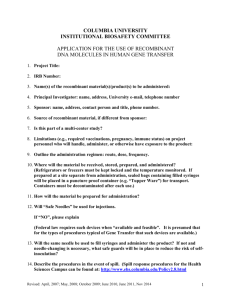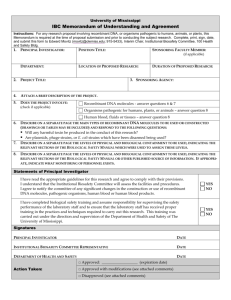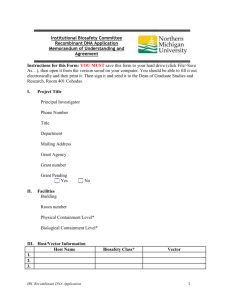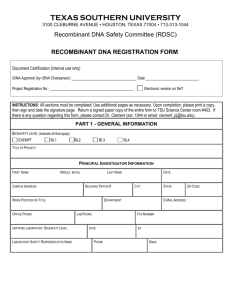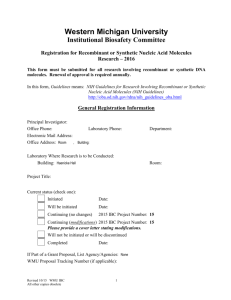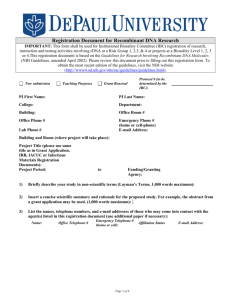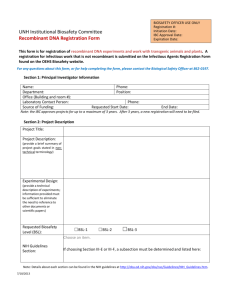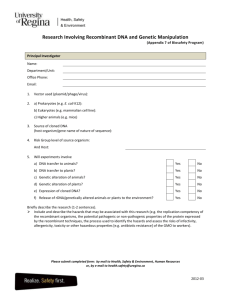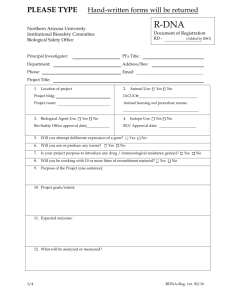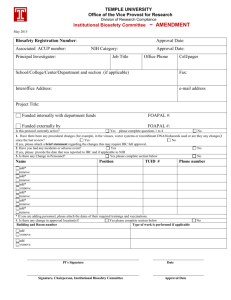Recombinant DNA Training - Environmental Health & Safety
advertisement
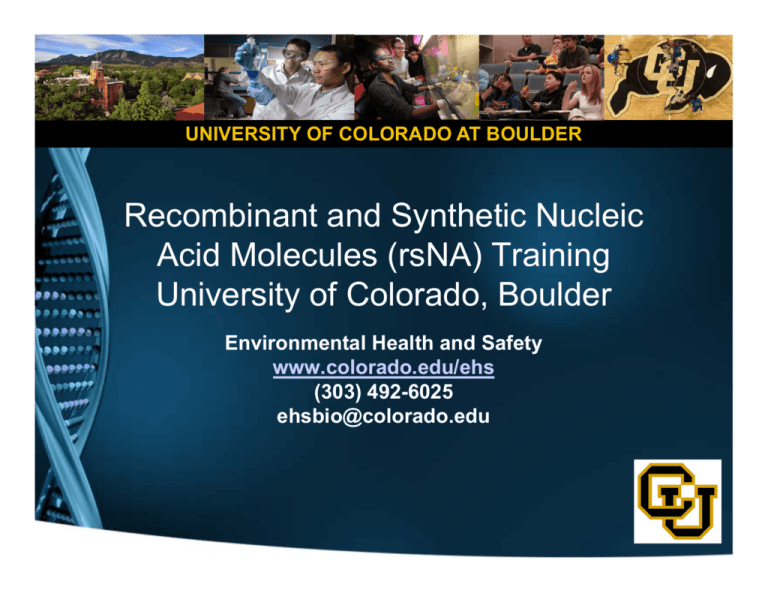
UNIVERSITY OF COLORADO AT BOULDER Recombinant and Synthetic Nucleic Acid Molecules (rsNA) Training University of Colorado, Boulder Environmental Health and Safety www.colorado.edu/ehs (303) 492-6025 ehsbio@colorado.edu Recombinant and Synthetic Nucleic Acid MoleculeTraining Introduction This training is designed to familiarize the Principal Investigator (PI) and lab personnel with the NIH Guidelines for Research Involving Recombinant or Synthetic Nucleic Acid Molecules (NIH Guidelines). NIH Guidelines are standards for containment and safe research practices involving recombinant or synthetic nucleic acid molecule (rsNA) activities. Pls are responsible for knowing the NIH Guidelines and training lab personnel as it pertains to your research. When finished, please complete the rsNA Quiz and e-mail it to EHSBIO@colorado.edu or mail it to 413 UCB. For more information, use the links provided Recombinant DNA Training Purpose and Scope of NIH Guidelines The purpose of the NIH Guidelines is to specify practices for constructing and handling: i. recombinant nucleic acid molecules ii. synthetic nucleic acid molecules, including those that are chemically or otherwise modified but can base pair with naturally occurring nucleic acid molecules iii. cells, organisms, and viruses containing such molecules Divided into five Sections (I-V) and fifteen Appendices (A-Q): Recombinant DNA Training Definition of Recombinant and Synthetic Nucleic Acid Molecules • In the context of the NIH Guidelines, recombinant and synthetic nucleic acids (rsNA) are defined as: • (i) molecules that a) are constructed by joining nucleic acid molecules and b) that can replicate in a living cell, i.e. recombinant nucleic acids; • (ii) nucleic acid molecules that are chemically or by other means synthesized or amplified, including those that are chemically or otherwise modified but can base pair with naturally occurring nucleic acid molecules, i.e., synthetic nucleic acids, or • (iii) molecules that results from the replication of those described in (i) or (ii) above. Recombinant DNA Training What are the NIH Guidelines? • Created in 1976 • Outlines principles for safe conduct of research employing rsNA technology • Detail practices and procedures for – containment of various forms of rsNA research – safe conduct of research involving genetically modified plants and animals, and – safe conduct of human gene transfer research. • Periodically revised and may be found at http://oba.od.nih.gov/rdna/nih_guidelines_oba.html • From NIH Office of Biotechnology Activities (NIH-OBA) Recombinant DNA Training What is the NIH Office of Biotechnology Activities (NIH-OBA)? The NIH Office of Biotechnology Activities (NIH-OBA) promotes science, safety, and ethics in biotechnology through the advancement of knowledge, enhancement of public understanding, and development of sound public policies. A core responsibility of NIH-OBA is to foster awareness of, and adherence to, the standards and practices set forth in the NIH Guidelines. Recombinant DNA Training NIH Recombinant DNA Advisory Committee (RAC) • Federal advisory committee providing advice and recommendations to NIH Director for rsNA research • Unique public forum for the discussion of science, safety, and ethics of rsNA research • Reviews and analyzes unique clinical gene transfer protocols and safety information • Observations and findings of general importance to the field • Not an approved process Recombinant DNA Training What is an Institutional Biosafety Committee (IBC)? • Provides local review and oversight of nearly all forms of research utilizing rsNA. • Reviews and approves all research subject to the NIH Guidelines. Approved applications are valid for 3 years. • Ensures that rsNA research conducted at or sponsored by the institution is in compliance with the NIH Guidelines. Recombinant DNA Training University of Colorado’s IBC • Reviews all University of Colorado at Boulder (UCB) activities involving biological agents or materials including educational and research laboratories, and field research. • Reviews and approves research that is conducted by UCB faculty and students at other institutions and non-CU entities. • Ensure that employees, students, the public and the environment are protected from biohazards associated with UCB operations. • Meets monthly. For additional information visit the Environmental Health and Safety (EHS) website. http://www.colorado.edu/ehs/research/biological.html Recombinant DNA Training Who Must Comply with the NIH Guidelines All institutions that receive NIH funding for rsNA research must comply with the NIH Guidelines. Researchers at institutions that are subject to the NIH Guidelines must comply with the requirements even if their individual projects are not funded by NIH. Recombinant DNA Training What are Potential Consequences of Noncompliance with the NIH Guidelines for NIH and Non-NIH Funded Projects? For NIH and Non-NIH funded projects involving rsNA: • suspension, limitation, or termination of NIH funds for the research project and of NIH funds for other rsNA research at the institution, or that of the Principal Investigator, or • a requirement for prior NIH approval of any or all rsNA projects at the institution. Recombinant DNA Training SAFETY CONSIDERATIONS Risk Assessment and Risk Groups (RG) NIH Guidelines require that the PI make an initial assessment of risk based on the Risk Group (RG) of an agent using Appendix B of the Guidelines, Classification of Human Etiologic Agents on the Basis of Hazard. Appendix B is based on the World Health Organization (WHO) Risk Classification. Recombinant DNA Training Basis for the Classification of Biohazardous Agents by Risk Group (RG) Risk Group 1 (RG1) Agents that are not associated with disease in healthy adult humans Agents that are associated with human disease Risk Group 2 which is rarely serious and for which preventative (RG2) or therapeutic interventions are often available Agents that are associated with serious or lethal Risk Group 3 human disease for which preventive or therapeutic (RG3) interventions may be available (high individual risk but low community risk) Agents that are likely to cause serious or lethal Risk Group 4 human disease for which preventive or therapeutic interventions are not usually available (high (RG4) individual risk and high community risk) Recombinant DNA Training Containment Requirements • The Biosafety Officer (BSO) and the IBC will review the agent itself and the proposed experiment procedures to determine the appropriate level of containment. • The levels of containment or Biosafety Levels are described in Appendix G of the Guidelines http://oba.od.nih.gov/rdna/nih_guidelines_oba.html and in the Centers for Disease Control and Prevention(CDC) guideline, Biosafety in Microbiological and Biomedical Laboratories, 5th ed. http://www.cdc.gov/biosafety/publications/bmbl5/ Recombinant DNA Training Experiments Covered by the NIH Guidelines: Section III-A Require IBC Approval, RAC Review, and NIH Director Approval Before Initiation Section III-B Require NIH/OBA and IBC Approval Before Initiation Section III-C Require IBC and Institutional Review Board Approvals and RAC Review Before Research Participant Enrollment Section III-D Require IBC Approval Before Initiation Section III-E Require IBC Approval Simultaneous with Initiation Section III-F Exempt Experiments Recombinant DNA Training Section III-A • The deliberate transfer of a drug resistance trait to microorganisms that are not known to acquire the trait naturally if such acquisition could compromise the ability to control disease agents in humans, veterinary medicine, or agriculture, will be reviewed by the RAC. • Consideration should be given as to whether the drug resistance trait to be used in the experiment would render that microorganism resistant to the primary drug available to and/or indicated for certain populations, for example children or pregnant women. • These experiments require IBC approval, RAC Review, and NIH Director approval before initiation and is considered a Major Action. Refer to Appendix D of the NIH Guidelines for Major Actions. Recombinant DNA Training Section III-B • Experiments Involving the Cloning of Toxin Molecules with LD50 of Less than 100 Nanograms per Kilogram Body Weight • Require NIH-OBA and IBC approval before initiation (may require CDC Select Agent registration if exempt quantities are not used). Section III-C • Experiments Involving the Deliberate Transfer of rsNA, or DNA or RNA Derived from rsNA, into One or More Human Research Participants • CU Boulder is not conducting in-vivo human gene therapy. Recombinant DNA Training Section III–D • Experiments require IBC approval before initiation There are 7 subcategories for Section III-D: Section III-D-1 Experiments Using Risk Group 2, Risk Group 3, Risk Group 4, or Restricted Agents as Host-Vector Systems (see Section II-A, Risk Assessment) Section III-D-2 Experiments in which DNA from Risk Group 2, Risk Group 3, Risk Group 4 or restricted agents is cloned into nonpathogenic prokaryotic or lower eukaryotic host-vector systems Recombinant DNA Training Section III–D Section III-D-3 Experiments involving the use of infectious DNA or RNA viruses or defective DNA or RNA viruses in the presence of helper virus in tissue culture systems Section III-D-4 This section covers experiments involving whole animals in which the animal's genome has been altered by stable introduction of rsNA, or nucleic acids derived therefrom, into the germ-line (transgenic animals) and experiments involving viable recombinant or synthetic nucleic acid moleculemodified microorganisms tested on whole animals. Recombinant DNA Training Section III–D Section III-D-5 Experiments to genetically engineer plants by rsNA methods, to use such plants for other experimental purposes e.g., response to stress), to propagate such plants, or to use plants together with microorganisms or insects containing rsNA. Section III-D-6 Experiments involving more than 10 liters of culture. The appropriate containment will be determined by the IBC. Section III-D-7 Experiments involving influenza viruses. Recombinant DNA Training Section III–E • This category includes experiments that are not included in Sections III-A through III-D, III-F and their subcategories are considered in Section III-E. These experiments may be conducted at BL-1 containment. • These experiments require IBC approval simultaneous with initiation. Recombinant DNA Training Section III–E There are 3 Subcategories for Section III-E: Section III-E-1 Experiments involving the formation of rsNA containing no more than two-thirds of the genome of any eukaryotic virus Section III-E-2 This section covers experiments involving nucleic acid molecule-modified whole plants, and/or experiments involving rsNA-modified organisms associated with whole plants, except those that fall under Section III-A, III-B, III-D, or III-F. Recombinant DNA Training Section III–E Section III-E-3 experiments involving the generation of rodents in which the animal's genome has been altered by stable introduction of rsNA, or nucleic acids derived therefrom, into the germ-line (transgenic rodents). Only experiments that require BL1 containment are covered under this section; experiments that require BL2, BL3, or BL4 containment are covered under Section III-D4, Experiments Involving Whole Animals. Recombinant DNA Training Section III–F • Experiments involving rsNA included in this category are exempt from NIH Guidelines. • The University requires that an IBC application be submitted for review and approval. • There are 6 subcategories for Section III-F. • Require IBC approval simultaneous with initiation. Recombinant DNA Training Other Institutional Committees and the IBC If you submit a protocol to the IACUC or IRB and it involves rsNA techniques or other biological materials, you must also submit an IBC application for review and approval. IRB IACUC IBC Recombinant DNA Training Principal investigator Responsibilities Responsible for full compliance with the NIH Guidelines during the conduct of rsNA research. The PI should: • Be adequately trained in good microbiological techniques. • Provide laboratory research staff with protocols describing potential biohazards and necessary precautions. • Instruct, train, and supervise laboratory staff in: (i) the practices and techniques required to ensure safety, and (ii) the procedures for dealing with accidents. • Inform the laboratory staff of the reasons and provisions for any occupational health/medical surveillance (e.g., vaccinations or restricted work duties). Recombinant DNA Training Principal investigator Responsibilities, continued • Correct work errors and conditions that may result in the release of recombinant or synthetic nucleic acid molecule materials. • Ensure the integrity of physical containment (e.g., biological safety cabinets) and biological containment (e.g., purity and genotypic and phenotypic characteristics). • Comply with permit and shipping requirements for recombinant or synthetic nucleic acid molecule materials. • Adhere to IBC-approved emergency plans for handling accidental spills and personnel contamination. Recombinant DNA Training Principal investigator Responsibilities, continued Before initiating research subject to the NIH Guidelines, the PI must: • Determine whether the research is subject to Section III-A, III-B, III-C, III-D, III-E, or III-F of the NIH Guidelines. • Propose physical and biological containment levels in accordance with the NIH Guidelines when registering research with the IBC. • Propose appropriate microbiological practices and laboratory techniques to be used for the research. • Submit an IBC application to the IBC for review and approval. Recombinant DNA Training Principal investigator Responsibilities, continued While conducting research subject to the NIH Guidelines, the PI must: • Determine the need for IBC review before modifying rsNA materials research already approved by the IBC. • Submit any changes to the IBC for review and approval. • Communication with the IBC for the duration of the project. • Report any significant problems pertaining to the operation and implementation of containment practices and procedures, violations of the NIH Guidelines, or any significant researchrelated accidents (e.g. needlestick) and illnesses to the Biological Safety Officer, the IBC, NIH-OBA, Animal Facility Director (where applicable), and other appropriate authorities within 30 days. Recombinant DNA Training Key Appendices - Appendix B CLASSIFICATION OF HUMAN ETIOLOGIC AGENTS ON THE BASIS OF HAZARD • Includes biological agents known to infect humans and selected animal agents that may pose theoretical risks if inoculated into humans. • Includes lists of representative genera and species known to be pathogenic. • Mutated, recombined, and non-pathogenic species and strains are not considered. • Non-infectious life cycle stages of parasites are excluded. Recombinant DNA Training Key Appendices - Appendix G PHYSICAL CONTAINMENT • Specifies physical containment for standard laboratory experiments and defines Biosafety Levels, consistent with the CDC Guideline, Biosafety in Microbiological and Biomedical Laboratories. • Use the following appendices to determine containment – For large-scale (over 10 liters) research or production, Appendix K shall supersede Appendix G. – For certain work with plants, Appendix P shall supersede Appendix G. – For certain work with animals, Appendix Q supersedes Appendix G. Recombinant DNA Training Key Appendices - Appendix K LARGE SCALE CONSIDERATIONS • Specifies physical containment guidelines for large-scale (greater than 10 liters of culture produced at one time) research or production involving viable organisms containing rsNA as specified in Section III-D-6, Experiments Involving More than 10 Liters of Culture. • Four biosafety levels of containment are established: - BL1-Large Scale (LS) - BL2-LS - BL3-LS - Good Large Scale Practice (GLSP) Recombinant DNA Training Key Appendices - Appendix Q CONTAINMENT FOR RECOMBINANT OR SYNTHETIC NUCLEIC ACID MOLECULE RESEARCH WITH ANIMALS • Specifies containment and confinement practices for research involving whole animals • Four biosafety levels of containment are established: - BL1-Animals (N) - BL2-N - BL3-N - BL4-N Recombinant DNA Training What does this mean to me? Apply to the IBC • If you are conducting any work with rsNA, you must complete an IBC application, regardless of your source of funding. • Even if considered “Exempt” from NIH Guidelines. • The University IBC reviews alI lab, field, and class activities involving biological agents and materials. • Currently, the University does not allow possession or use of Risk Group 3 or 4 agents • Currently, the University does not allow possession or use of Select Agents or Toxins that would require registration with the CDC or USDA. Recombinant DNA Training Things to Remember The IBC and Biosafety Officer can help you: – Ensure that you are working with rsNA safely – Meet all compliance requirements associated with NIH funding for research involving recombinant or synthetic nucleic acid molecules – Avoid preventable accidents and incidents that might cause harm or undermine public confidence in your research activities – Obtain biosafety advice on an ongoing basis Recombinant DNA Training QUESTIONS? Contact Information Environmental Health and Safety 1000 Regent Drive Boulder, CO 80302 ehsbio@colorado.edu (303) 492-6025 www.colorado.edu/ehs Recombinant DNA Training THANK YOU You are now ready to take the required rsNA Quiz
